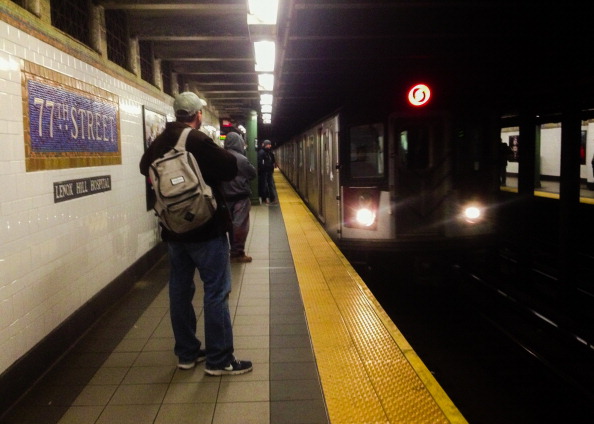
If you’re already a bit anxious on subways without platform edge doors, the story of people being pushed to their death onto subway tracks isn’t going away anytime soon.
Some variation of that incident—nothing new, despite its shock factor—probably comes to mind nearly every day: when someone teeters off the platform’s edge, for instance, or when you step past the yellow line to circumvent a crowd. The fears over subway deaths, already high after a sensationalized subway murder in 2013, only grew this week with reports of New York’s latest subway accident. In the same way you can’t avoid gawking at a car crash, you can’t avoid reading about a subway death, either.
Hard numbers about subway safety data — New York had only 53 subway fatalities in 2013, a year when it carried 6 million riders — don’t always have a sobering effect on the hysteria following transportation tragedies. Unlike other transportation accidents that get mass media coverage, like a plane crash, a subway accident, especially one so brutal as this week’s in New York City, has a distinct immediacy for a city’s residents. It is not far off in a foreign country, or the result of an extraordinary circumstance. Instead, it’s a few inches and a push, trip or slip away.
That’s a strange concept in an era when new technologies are emerging every day to protect us from death before we’ve even harmed, like cars with radar-based brakes or airplanes with ground proximity warning systems. So why hasn’t technology made subways more safe? Cost.
“[The lack of subway safety] is driven by a cost culture rather than a safety culture,” says former National Transportation Safety Board chairman James Hall. “You will invariably have innocent individuals literally fall through the holes of that type of structure. It’s a matter of priorities, and making safety your most important priority.”
Among the most effective subway safety measures are platform edge doors, which blocks off access to the tracks until a train arrives. However, the cost of installing such doors throughout the New York City subway system is “in the billions,” according to Kevin Ortiz, a spokesman for the Metropolitan Transportation Authority, which oversees New York City’s subway. Ortiz said a contractor has been designing a door system since last month, while new technologies to detect objects or people on the tracks are being tested in the city’s subway. However, the MTA has no timelines for rolling out the new systems on a broader scale.
Platform edge doors are common sights in major cities around the world, including St. Petersburg, Beijing and Tokyo. But those systems are relatively young, and they were built with the platform doors to begin with. Many subway systems in America (and London’s Tube) are old: New York’s dates back to 1904, Boston’s to 1901, and Chicago’s to 1897. Retrofitting older systems to feature platform doors is a much costlier proposition than building a new one with the doors from the get go. Interestingly, New York City’s “Airtrain,” a light rail-style system connecting John F. Kennedy International Airport with the city’s subway system, has platform doors — but it’s only been open since 2003.
Instead of spending money on costly safety technology to make the subway systems safer, the organizations that run them tap into riders’ fears to ensure they stay safe around the trains. In New York, for example, the MTA for decades has run a poster campaign informing riders how many fatalities have occurred in the past year, a reminder to stay well clear of the tracks when a train isn’t in the station. And last year, members of MTA’s largest employee union distributed flyers designed as fake blood-stained subway cards to demand slower trains, improved braking mechanisms and protective barriers.
And platform doors might not be a necessary expense, anyway, as the data shows subways are actually pretty safe.
“Obviously one [fatality] is one too many,” said the MTA’s Ortiz. “But in the grand scheme of things, when you move six million people a day, you have a greater likelihood of being hit by lighting twice than being struck by a subway train.”
Still, there are statistics to support the other side, too. In New York City, one-third of subway deaths are ruled suicides made possible by the tracks’ easy access; subway operators are trained to expect one death per week; if an operator’s train strikes a person, he or she is given just three days off to recover from the trauma.
As a result, most people who care about subway safety fall into one of two camps: either the subway seems like one of the most dangerous form of transportation, or one of the safest. But if there’s one aspect that’s agreed upon by nearly all subway riders, personnel and experts, it’s that a safer subway system, however expensive, is an expectation within reach.
“Cars without drivers, parking assist, collision avoidance—we’re able to do all these kinds of technologies,” said Carl Berkowitz, a transportation and traffic engineering expert. “We should be able to solve some of the problems we have in the subway system.”
More Must-Reads from TIME
- L.A. Fires Show Reality of 1.5°C of Warming
- Home Losses From L.A. Fires Hasten ‘An Uninsurable Future’
- The Women Refusing to Participate in Trump’s Economy
- Bad Bunny On Heartbreak and New Album
- How to Dress Warmly for Cold Weather
- We’re Lucky to Have Been Alive in the Age of David Lynch
- The Motivational Trick That Makes You Exercise Harder
- Column: No One Won The War in Gaza
Contact us at letters@time.com